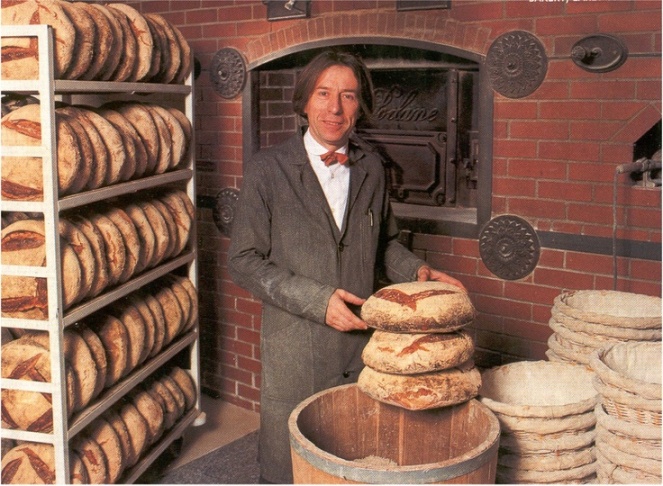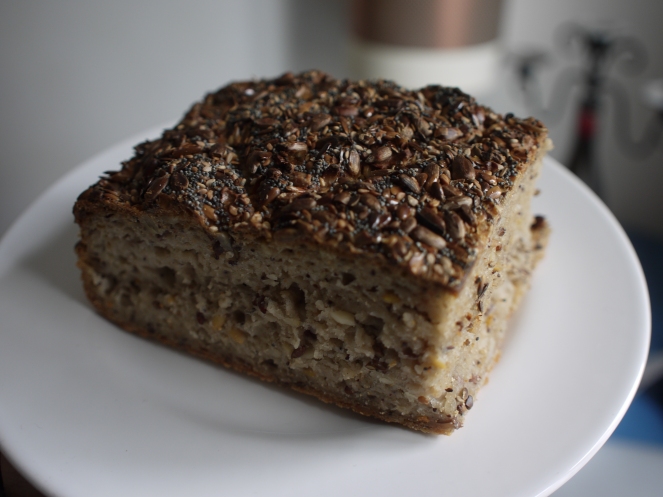It’s been a while since I last wrote, but I have a good excuse. Last week, I took my study of bread out of my little country town and into the magical city of Paris!

It was a great trip. I spent a week seeing the sights, attending art exhibitions and book readings, wandering cobblestoned alleyways, getting around by metro and bike, catching up with old friends, and eating yummy food. Being the hopeless romantic that I am, it didn’t take me more than 20 minutes to fall head-over-heels in love with Paris. Every time I caught a glimpse of the Eiffel Tower, or heard someone playing the accordion, or noticed a scene that seemed to come straight out of an old French film, I felt like throwing my arms up as Audrey Hepburn does in Funny Face and singing at the top of my lungs, “BONJOUR PARIS!”

I could go on and on about my week in Paris, how much I adored it, and the countless fantasies I had of settling down there for the rest of my life. But seeing as my time (and yours) is limited, I’ll cut to the chase and get to the real reason I’m here: bread!
A major reason I went to Paris was to get a taste of the city life I’ve been missing while living in the Provençal countryside. However, another reason I went was for the bread. Bread is a big deal where I live in the south, but I’d argue that it’s an even bigger deal in Paris. Why? For one, several historical events took place in Paris that were connected to bread. It was in Paris that the French stormed the Bastille when the price of bread skyrocketed- an event which many believe triggered the French Revolution. For another, Paris prides itself on being home to some of the greatest bakers and bakeries. I wanted to see if this was true, if bread in Paris is truly better than bread in other parts of France.
And so, going about it as any amateur would, I did a Google search for the “best bakeries in Paris,” scrolled through the results, and jotted down a few bakeries to check out.
The first bakery I visited was the distinguished Poilâne bakery on Rue de Cherche-Midi of the Latin Quarter. Now, if you haven’t heard about Lionel Poilâne and his famous sourdough miches, don’t worry. Neither had I. It wasn’t until after I visited the bakery that I discovered just how renowned Poilâne is in the world of bread.

Perhaps “renowned” is too lacking a word to describe Lionel Poilâne’s reputation. To many, he was the quintessential Parisian baker, the king of sourdough in France. The original bakery at Cherche-Midi was opened in 1932 by Lionel’s father, Pierre Poilâne, where he made more traditional (if not as popular) sourdough loaves. Lionel began working at the bakery at the age of 14, and what began as a humble family business soon expanded into a global enterprise as Poilâne’s loaves gained recognition among restaurant owners, artists, and food critics. When Lionel and his wife were tragically killed in a helicopter crash in 2002, the business was taken over by their eldest daughter, Apollonia. In remembrance of her father and grandfather, Apollonia continues to make Poilâne bread using a combination of old and new techniques and the finest ingredients, including stone-ground flour, sea salt from Guérande, and wood-fired ovens.
I stopped by Poilâne on a Thursday morning on my way to the Saint-Germain district. Upon entering the bakery, I was surprised at how quiet it was. Contrary to my expectations, there were no lines or crazed tourists with cameras. Instead I was met by a couple of employees in white coats and row after row of rectangular loaves, pastries, cookies, tarts, fruit preserves, and, of course, the legendary Poilâne miches. A woman approached me to take my order, but I stuck around for a few minutes to check out their products and snap a few photos.


In the end I ended up buying a couple of their “mini breads”- a whole wheat loaf and a rye/raisin loaf. I later regretted not buying a miche (or even one of their apple tarts, which are said to be extraordinary) when I had the chance, but looking back I think I felt overwhelmed by the multitude of options and, frankly, by the size of the miches themselves. Nevertheless, the bread I did buy was some of the best bread I’ve ever tasted. Chewy, light in texture, and yet wholly substantial and satisfying, I immediately understood why Poilâne bread has the reputation it does.
In addition to Poilâne, I also visited Du Pain et des Idées, an old-school bakery in the 10th arrondissement; Maison Kayser, an artisanal bakery with multiple locations in Paris and around the world; Stohrer, the oldest pâtisserie in Paris, opened in 1730 by Louis XV’s pastry chef; and Chambelland, a gluten-free bakery in the hip 11th arrondissement. Each place had its own delights and specialties– chocolate-pistachio croissants at Du Pain, sans gluten poppy and sunflower seed cookies at Chambelland– that made my mouth water, my heart melt, and my pants a tad tighter. After visiting each bakery, I thought to myself, “This is the best bread I’ve tasted in Paris!” But to tell you the truth, they were all good.






And so, to answer my original question: Is bread in Paris better than bread in other parts of France?
*drumroll*
Yes. And no.
As far as I could tell, the bread in Paris wasn’t too different from the bread in other parts of France. Sure, the quality of the ingredients is probably higher and the baking methods more refined; however, they don’t vary too drastically from the ingredients and methods used by village bakers in the countryside. While there was a greater variety of bread and bakeries, the baguettes were no more golden, aromatic, or chewy than other baguettes I’ve had, nor were the croissants more luxurious, flaky, buttery, raisin-filled, or chocolatey than those found at my local bakery.
But, for some reason, the bread and pastries in Paris were better. Or, at least, they were more enjoyable to indulge in. I’ve thought a lot about why this is so, and the only sensible conclusion I’ve come to is that it is the charm of being in Paris, rather than the bread itself, that makes Parisian bread taste better.
You see, there’s something both romantic and powerful about eating a baguette in La Ville Lumière. It’s a city that housed royalty, oversaw a bloody revolution, inspired artists and intellectuals, and is the center of gastronomy as we know it. As I ate my Poilâne bread on a bridge overlooking the Seine, I felt chic, optimistic, nostalgic, and content all at once. It was a strange mix of feelings that I seldom feel, and that I doubt could be replicated anywhere else in the world but in Paris.
~~~
For further information on the bakeries I visited:
“Bread Winner” (New Yorker article about Poilâne as run by Lionel’s daughter, Apollonia)
Du Pain et des Idées Official Website
Maison Kayser Official Website
Pâtissier Stohrer Official Website
“In Paris Bakeries, Liberté From Gluten” (New York Times article about gluten-free bakeries in Paris)

This is wonderful, Paige! Great info for next time I get to visit France.
You might consider looking into the specific wheat types and milling processes used in France vs. the US. Last time I visited France I brought home bags of flour to see if that was the missing link to making a good baguette here. Using my usual recipe with French flour changed my results for the better, it was surprising.
(Mrs. Hull)
LikeLike
Thanks, Mrs. Hull! That’s a great point- I will definitely look into the various milling processes as I’m sure it’s all connected to the quality of the loaf 🙂
LikeLike